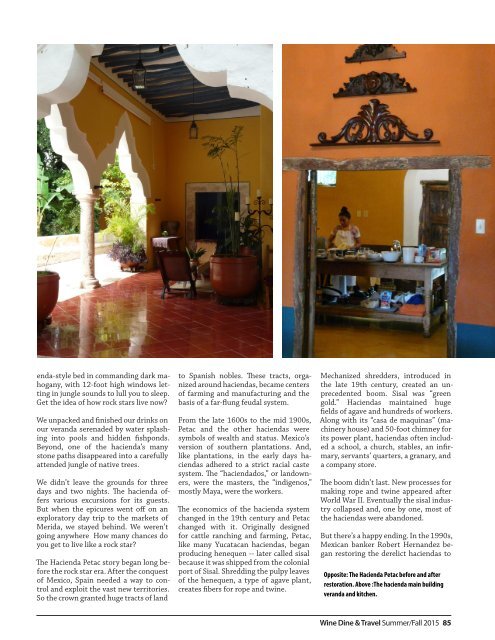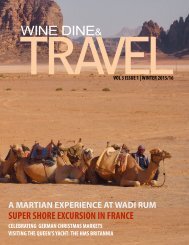WINE DINE & TRAVEL MAGAZINE SUMMER FALL 2015 HD.pdf
This issue features Washington State wines, from Seattle to Walla. Join Ron and Mary James on a tasty adventure in northwest wine country.
This issue features Washington State wines, from Seattle to Walla. Join Ron and Mary James on a tasty adventure in northwest wine country.
- No tags were found...
You also want an ePaper? Increase the reach of your titles
YUMPU automatically turns print PDFs into web optimized ePapers that Google loves.
enda-style bed in commanding dark mahogany,<br />
with 12-foot high windows letting<br />
in jungle sounds to lull you to sleep.<br />
Get the idea of how rock stars live now?<br />
We unpacked and finished our drinks on<br />
our veranda serenaded by water splashing<br />
into pools and hidden fishponds.<br />
Beyond, one of the hacienda’s many<br />
stone paths disappeared into a carefully<br />
attended jungle of native trees.<br />
We didn’t leave the grounds for three<br />
days and two nights. The hacienda offers<br />
various excursions for its guests.<br />
But when the epicures went off on an<br />
exploratory day trip to the markets of<br />
Merida, we stayed behind. We weren’t<br />
going anywhere How many chances do<br />
you get to live like a rock star?<br />
The Hacienda Petac story began long before<br />
the rock star era. After the conquest<br />
of Mexico, Spain needed a way to control<br />
and exploit the vast new territories.<br />
So the crown granted huge tracts of land<br />
to Spanish nobles. These tracts, organized<br />
around haciendas, became centers<br />
of farming and manufacturing and the<br />
basis of a far-flung feudal system.<br />
From the late 1600s to the mid 1900s,<br />
Petac and the other haciendas were<br />
symbols of wealth and status. Mexico’s<br />
version of southern plantations. And,<br />
like plantations, in the early days haciendas<br />
adhered to a strict racial caste<br />
system. The “haciendados,” or landowners,<br />
were the masters, the “indigenos,”<br />
mostly Maya, were the workers.<br />
The economics of the hacienda system<br />
changed in the 19th century and Petac<br />
changed with it. Originally designed<br />
for cattle ranching and farming, Petac,<br />
like many Yucatacan haciendas, began<br />
producing henequen -- later called sisal<br />
because it was shipped from the colonial<br />
port of Sisal. Shredding the pulpy leaves<br />
of the henequen, a type of agave plant,<br />
creates fibers for rope and twine.<br />
Mechanized shredders, introduced in<br />
the late 19th century, created an unprecedented<br />
boom. Sisal was “green<br />
gold.” Haciendas maintained huge<br />
fields of agave and hundreds of workers.<br />
Along with its “casa de maquinas” (machinery<br />
house) and 50-foot chimney for<br />
its power plant, haciendas often included<br />
a school, a church, stables, an infirmary,<br />
servants’ quarters, a granary, and<br />
a company store.<br />
The boom didn’t last. New processes for<br />
making rope and twine appeared after<br />
World War II. Eventually the sisal industry<br />
collapsed and, one by one, most of<br />
the haciendas were abandoned.<br />
But there’s a happy ending. In the 1990s,<br />
Mexican banker Robert Hernandez began<br />
restoring the derelict haciendas to<br />
Opposite: The Hacienda Petac before and after<br />
restoration. Above :The hacienda main building<br />
veranda and kitchen.<br />
Wine Dine & Travel Summer/Fall <strong>2015</strong> 85
















